Where Patients & Providers Act: The Point of Care Advantage

As planning season approaches, more brands are considering Point of Care (POC) as a key channel to reach and convert audiences. Why? Because they’re seeing real results. With POC you can:
- Deliver your messaging in inherently trusted spaces such as pharmacies, healthcare provider offices, and established digital health platforms where audiences are more receptive.
- Reach patients and caregivers in the moments before they interact with HCPs – moments where they’re much more likely to act.
- Optimize your marketing investment with more efficient, hyper-targeted messaging proven to drive behavior.
- Increase your likelihood of conversion by exposing your audience to messaging across both in-person and digital channels.
Point of Care Is Growing as a Channel as Brands Take Note of Its Effectiveness
Point of Care marketing is a rapidly expanding channel in healthcare advertising, experiencing revenue growth of 171% from 2019 to 20231. As a channel, POC is growing at a rate of 22% year over year 1.
This expansion is driven by POC’s unique ability to deliver personalized messaging at pivotal decision points in the healthcare journey, creating moments of action when they matter most.
Leading pharmaceutical companies like Novartis and Bristol Myers Squibb are investing heavily in this channel, recognizing its proven effectiveness in reaching patients, caregivers and healthcare professionals efficiently.
POC can help you catalyze not just engagement, but real impact. Here are five reasons why POC should be a cornerstone of your media investment in 2026.
POC Connects Brands With Patients, HCPs and Caregivers Alike – At Times Where Their Attention Matters Most
POC marketing is a unique channel in the healthcare ecosystem because it delivers tailored messaging when it matters most. By precision-targeting messaging at pivotal moments of patient engagement, POC marketing delivers outsized impact through strategically placed interventions.
Its role extends beyond simply creating awareness; POC actively connects patients, healthcare providers, and caregivers with the information, products, and services that meet their needs.
And it connects with patients and their care partners at vulnerable stages in their health journey—moments when they seek reassurance, clarity, and prepare to make decisions that affect their quality of life.
This approach benefits everyone involved: patients and HCPs receive highly relevant support, caregivers gain clarity, and marketers can improve patient outcomes.
For patients, POC messaging delivers content when it’s most impactful—within clinical settings or pharmacies—reinforcing key health choices and empowering them with trustworthy information. Caregivers, often vital in health decision-making, benefit from POC materials that provide them with tools to support loved ones effectively.
For marketers, POC is more than a channel— it’s a strategic catalyst that transforms clinical interactions from transactional exchanges into meaningful dialogues.
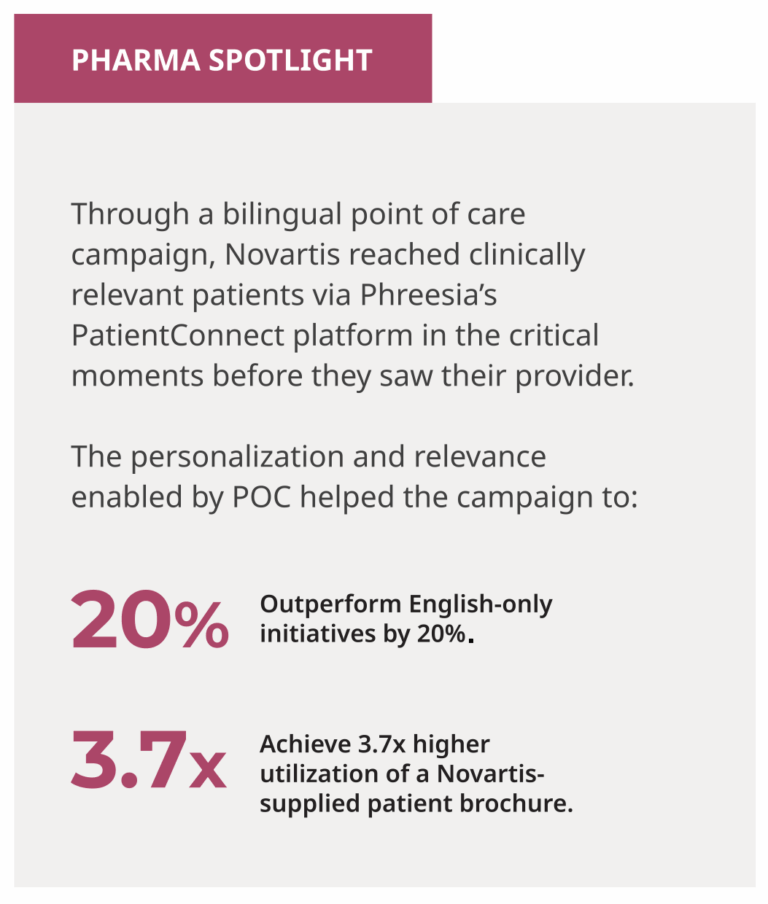

Leqvio & Pelacarsen (ASCVD/Cardiovascular)
Novartis
Point of Care Marketing Helps You Reach and Educate Information-Hungry Consumers – Who Are Now “Shopping” for Health Products
Instead of viewing healthcare simply as a discrete series of visits or interventions, patients are moving toward a more dynamic, collaborative process—collecting, interpreting, and integrating health information over time to make better-informed decisions.
Patients are now actively “shopping” for healthcare products and services beyond traditional clinical settings, often managing personal health data—like blood sugar levels—through wearables and health apps without direct medical oversight.
But the information they find isn’t always credible or easy to digest. 55% of people worry about misinformation influencing health decisions4. And 40% of frequent health information seekers experience emotional distress due to excessive online searching, often leading to increased health anxiety2.
POC materials can bridge this gap by simplifying medical information into clear, accessible content.
Consumer and Patient Behavior Is Changing in Healthcare Settings – Meet the Moment With Your Advertising
- 80% of consumers are interested in using digital tools to manage their health7
- Nearly 60% of consumers actively use online resources to research symptoms, treatments, and healthcare providers before consulting a physician7
- 84% of patients value digital education materials provided by a doctor or hospital (e.g., video links, digital brochures, etc.) including 74% who value digital screens or tablets and 70% who value health related television programs in doctor’s office/hospital2
- 78% of patients valued brochures, posters other health education materials and 81% health-related publications2
- 68% of patients value digital patient support information2
- Nearly 2 in 3 (65%) patients value pharmacy’s print brochures or other take-home materials2
- 54% of patients research treatment options on their own and then ask their doctor about them, up 10% since 20222
POC marketing excels at delivering relevant, contextual information when patients are most attentive and prepared to act.

Information Delivered at the Point of Care is Highly Trusted
POC Helps Brands Build Recall and Inspire Action in the Trusted Spaces Where Patients, Caregivers and HCPs Spend Their Time.
Healthcare visits heighten patient focus and engagement, and POC marketing leverages these moments to provide valuable information.
A majority of people value in-person health information from their doctor’s office or hospital2, which makes POC settings important touchpoints in the patient journey. The value individuals place on information they receive at the point of care complements the marketer’s goal to deliver meaningful content.
In a time where trust in health reporting is declining4, POC leverages the authority from HCPs to educate and support patients. POC reaches patients, HCPs and caregivers while they’re in trusted settings like pharmacies, doctors offices and on digital platforms, which assists in better adherence, compliance and health outcomes.
Healthcare providers are the most trusted source for health information4. Messaging at the POC engages patients when health is top of mind and when patients are in the mindset to heed recommendations.
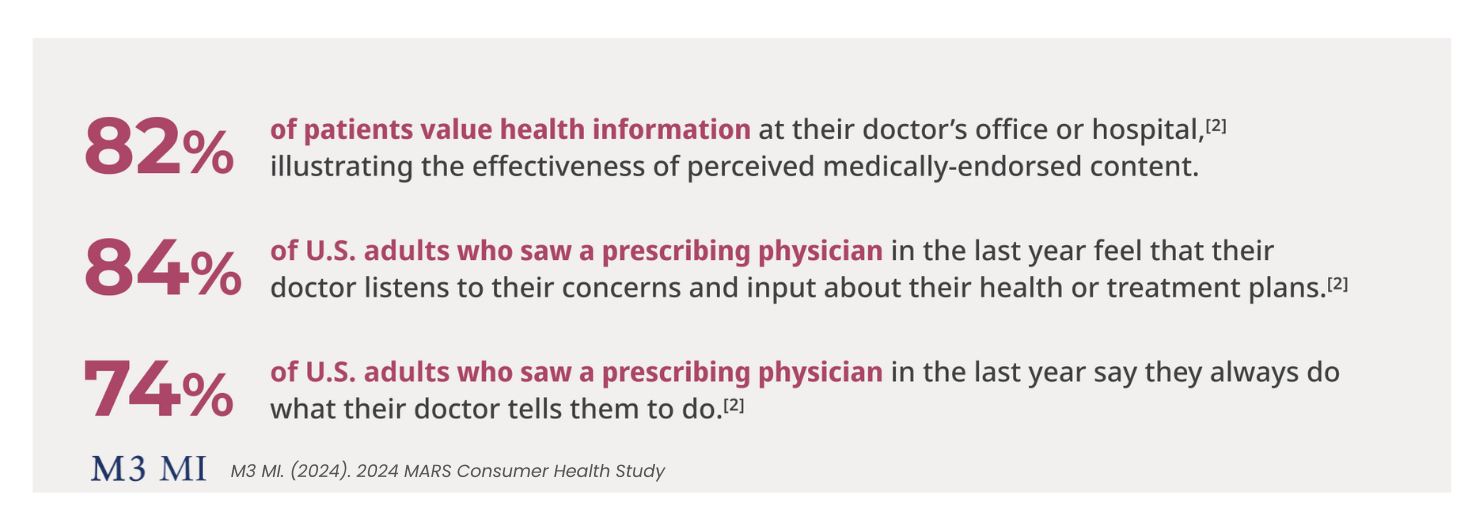
HCPs are at the heart of trusted interactions – POC puts your brand in those interactions, too. Among top 10 health information sources, POC ranks just below HCPs and before other channels like health information websites, health-related publications or search engine results2.
- Doctor
- Nurse/PA
- Pharmacist
- Health information at POC
And when patients ranked health information channels by effectiveness, POC materials came out on top for trust, beating health websites, TV and social media3.

Bristol Myers Squibb
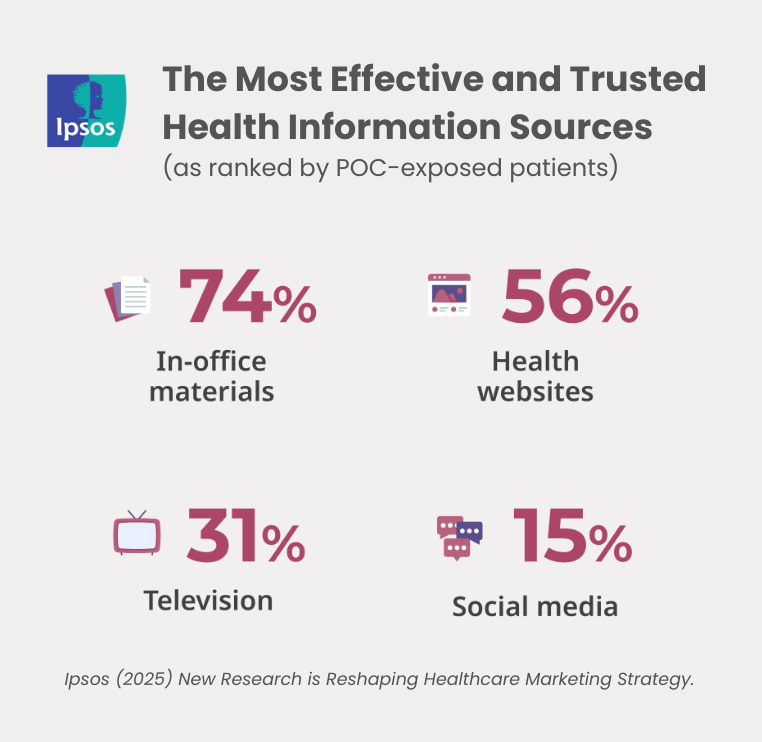
For marketers, this preference for POC should prompt a rethink of channel mix. While TV and digital platforms often consume the lion’s share of healthcare marketing budgets, POC continues to outperform in trust, particularly for categories that require deeper education, clinical alignment or behavioral change.
Because of Its Targeting Capabilities, Context, Relevance and Trusted Reputation, POC Marketing is Not Only Informative, But Effective in Driving Action
Those exposed to POC messaging are also more likely to act.
While many channels promise engagement, research documents that POC catalyzes behaviors that directly impact brand success:
- For instance, 58% of patients and caregivers who encountered a pharmaceutical ad in-office reported that it made them more knowledgeable about their medications—a 12% increase from previous years2
- Patients exposed to ads at POC are more likely to take/refill prescriptions than those who saw them on TV2
- 60% felt more empowered to take action 3
- 42% of patients saw a healthcare ad in the doctor’s office within the last year2. Among those who saw a healthcare ad in this setting:
58% of patients or caregivers were willing to discuss the advertised treatment with their doctor2.
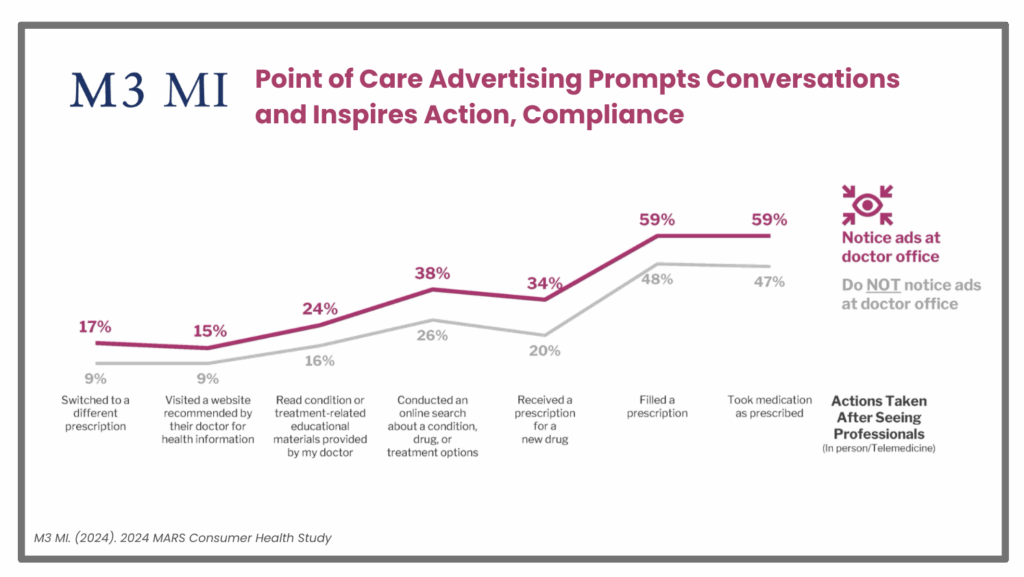
These self-reported behavior changes demonstrate POC’s ability to positively impact patient behavior and how POC ads effectively support patients seeking to understand their health options. The direct correlation between POC exposure and medication initiation/adherence creates a compelling case for strategic investment.
![CASE STUDY Veeva Crossix Dual exposure boosts conversions This synergy—rooted in net conversion rate analysis—demonstrates POC's ability to reinforce digital efforts and guide patients toward action. Compared to the other channels, POC was the most efficient. 200x Patients exposed to both digital and POC ads were 200x more likely to convert.[5] 14% POC represented just 14% of the total media investment but generated 35% of new patient starts.](https://www.pocmarketing.org/wp-content/uploads/2025/07/Screenshot-2025-07-25-at-4.47.06-PM.png)

POC Increases Quality of Care & Patient Outcomes
POC doesn’t just yield better outcomes for the marketer. It plays a significant role in allaying fears about medicine and healthcare, while also encouraging patient participation in their own care. Research shows a strong emotional benefit tied to POC exposure, with patients reporting greater clarity and confidence:
- 80% of patients report that POC education increases care satisfaction6
- 83% of POC-exposed patients feel reassured about their healthcare direction (vs. 76% unexposed)3
- 81% feel relieved about having clear next steps (vs. 72%)3
Providers who use POC also report clear benefits:
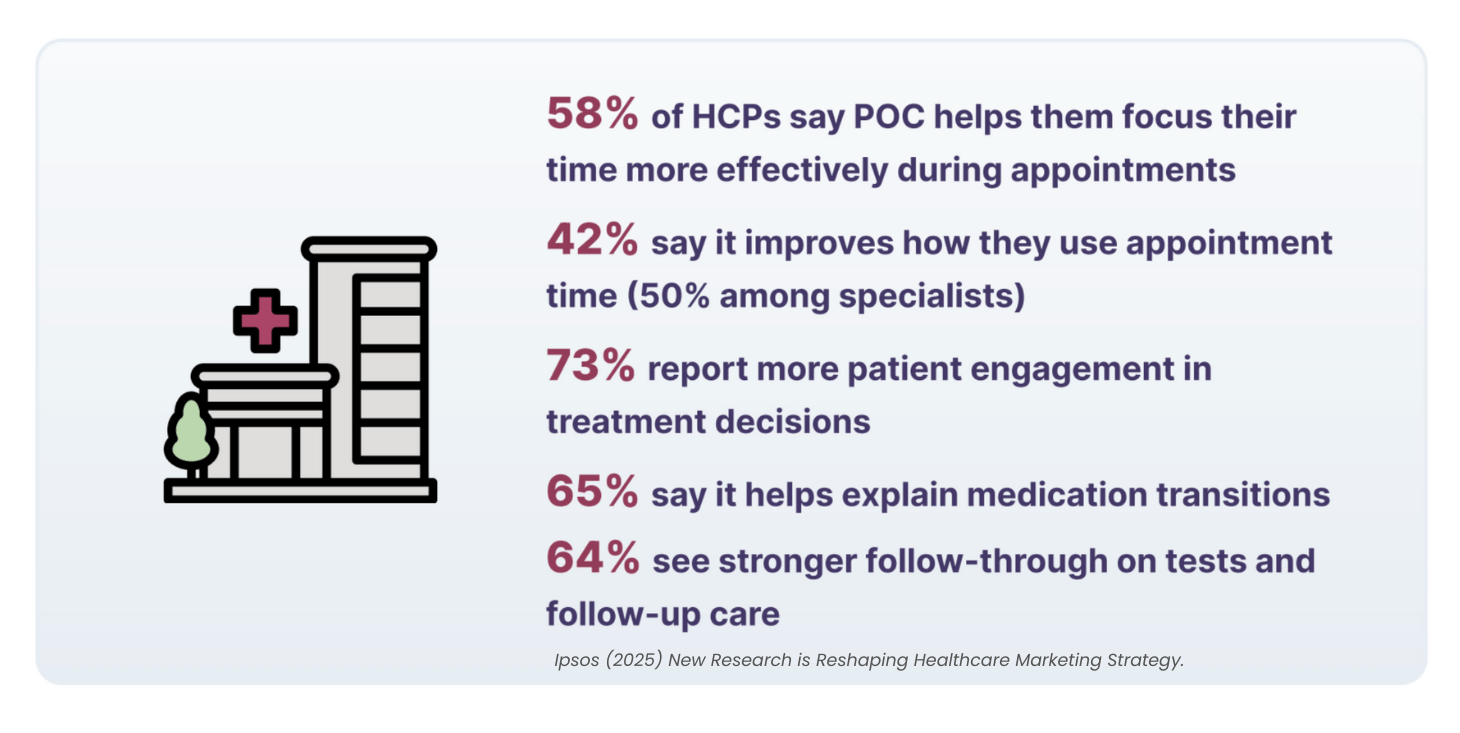
The Bottom Line: Why Point of Care Deserves Your 2026 Investment
As healthcare and consumer behaviors evolve, Point of Care marketing stands out as a proven, effective and trusted channel to engage patients, caregivers and HCPs at the moments that matter most. Its unparalleled targeting capabilities, combined with its presence in highly trusted clinical settings, drive greater awareness, deeper education and measurable action.
Brands leveraging POC aren’t just reaching their audiences—they’re empowering them with timely, relevant information that leads to better health decisions and improved outcomes. As you plan for 2026, investing in Point of Care is more than adding another touchpoint to your media mix; it’s about transforming pivotal moments into meaningful action for patients and measurable impact for your brand.
Reach out to members of the Point of Care Marketing Association to learn more about their offerings and how you can leverage POC to deliver better outcomes. For a complete list of members, visit https://pocmarketing.org/membership/meet-our-members.
[1] POCMA. (2024). Healthcare industry spending details. [Internal data] sourced POCMA member reporting
[2] M3 MI. (2024). 2024 MARS Consumer Health Study
[3] Ipsos (2025) New Research is Reshaping Healthcare Marketing Strategy.
[4] M3 MI (2024) Professional Health Studies: Physician Digital Insights Study and Sources & Interactions Study
[5] Veeva Crossix, 2023
[6] Zhang, X., Chen, X., Wen, H., & Zhao, X. (2024). Online health information seeking during the COVID-19 pandemic: A cross-sectional survey of Internet users in 10 countries. Journal of Medical Internet Research, 26(1), e51186.
[7] Deloitte. (n.d.). The future of health: A focus on the consumer. Deloitte. Retrieved January 27, 2025
*Based on net conversion rates for digital only and digital + POC
